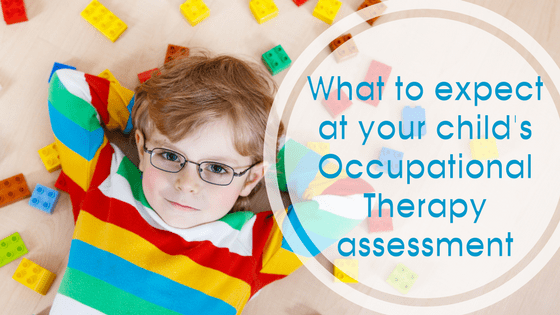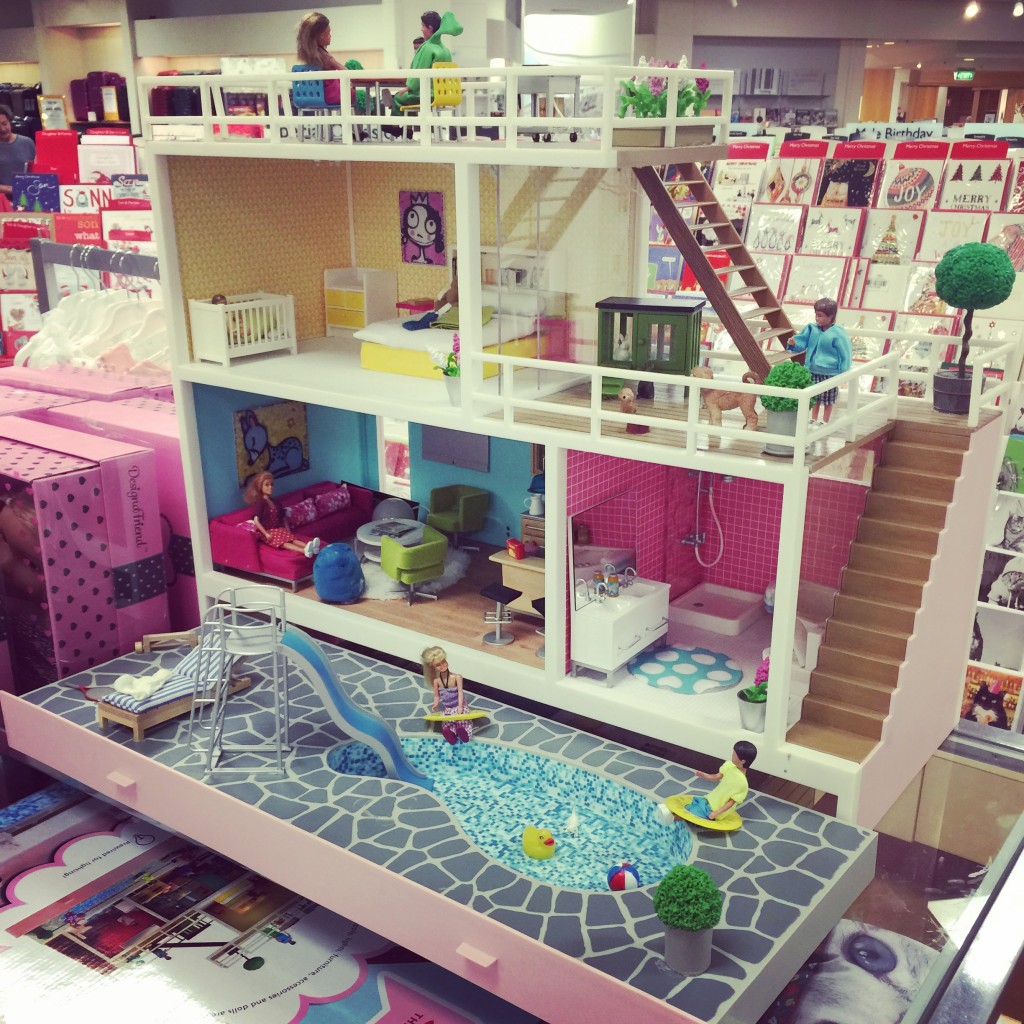If you’re the parent of a child who has been referred to an Occupational Therapist for support, then chances are you’re not quite sure what to expect from the process. Unless you’ve had a child undertake Occupational Therapy in the past, or have been close to someone else who has, you may not know exactly what’s going to happen in those first few sessions.
Today’s post is all about the paediatric OT assessment. The good news is, an OT assessment is likely to be the most fun assessment your child will ever undertake. Many of the tools we use are play-based, because we use play as our primary means of therapy and of understanding a child’s functional skill level. But it’s also important to remember that any time a child, or their parent, meets a new therapist it can be a little nerve-wracking, especially if you don’t know what to expect. So here’s a few notes on what’s likely to happen in the OT assessment process.
Before the assessment:
A pre-screening questionnaire:
Many Occupational Therapists, including those at Bloom Wellbeing, will ask parents to complete a pre-screening form prior to the assessment day – which you will either return prior to the assessment, or bring with you on the day. This questionnaire is likely to have questions about your child’s medical and social history and development, as well as questions about their strengths and weaknesses, and any goals you have for OT intervention. This questionnaire is an opportunity for us to gain relevant background information from the parent or guardian which will help to inform our assessment process. It’s useful for parents or guardians to fill this out in advance, as it gives you the chance to think through your answers, and it also saves a lot of time in the clinic room during the assessment.
During the in-clinic assessment:
Firstly, you should know that an Occupational Therapy “clinic room” doesn’t really look very “clinical” – it actually looks like a big playroom – with movement based play equipment, and a range of toys are games to engage your child. It’s a great idea to make sure your child is wearing clothes suitable for play – things that are easy to move around in and something you don’t mind getting dirty (ie covered in finger pain or shaving cream!); shorts, pants or leggings are better options than dresses and skirts to allow free movement; layers are handy in case your child gets warm during activities; and socks are a great option for hygiene, as we do a lot of activities without shoes.
It’s also important to understand that the assessment process can take 2 to 3 sessions – particularly if there is a separate parent interview undertaken.
Parent interview:
The Occupational Therapist is likely to want to discuss in a little more detail the information you provided in your pre-screening – this helps to clarify any important sections, or to perhaps provide additional information for other areas. At Bloom Wellbeing, we prefer this first session parent interview to be held with just the Occupational Therapist and parent/guardian – without the child present. This means the parent can talk freely about their concerns and queries, without little ears listening in. It also means that during the first child-based session, the Occupational Therapist can be fully focused on the child, undertaking activities together.
Play assessment:
You may be wondering why the OT seems to just be playing make-believe with your child, rather than assessing them. However, when the OT is down on the floor playing, they’re actually observing your child’s play skills closely. They will be looking at different components of your child’s play, including the play themes they use, how they use objects during play and the creation of play storylines.
Gross motor skills assessment:
“Gross” motor skills refer to the big body movements your child undertakes. Tasks such as walking, running, jumping, throwing, crawling, dancing, rolling, sitting down, standing up and balancing all fall into this category. These tasks may be assessed through a standardised assessment such as the “Movement ABC” assessment, or it may be conducted through skilled observation of your child undertaking these type of tasks, and relating them back to age-based skill expectations.
Fine motor skills assessment:
“Fine” motor skills generally relate to tasks your child undertakes with their hands – including drawing, colouring, playing with small items, using cutlery, doing up buttons and zips, or tying shoelaces. As for gross motor skills, these fine motor skills might be assessed with a formal assessment tool such as the “Movement ABC” – or it might be conducted informally through engaging your child in a range of age-scaled fine motor tasks – such as playing with marbles, threading beads, playing with lego or cutting shapes out of paper.
Visual-motor co-ordination assessment:
This part of the assessment concerns how well your child’s vision and motor skills work together – you’re probably familiar with the term “hand-eye co-ordination” – and this is part of visual motor co-ordination. This task is likely to be a pencil and paper assessment, such as the Beery Buktenica Development Test of Visual Motor Integration.
Handwriting assessment:
If your child is at pre-school or school age their OT assessment may include a handwriting component. This generally consists of pencil and paper tasks, including drawing “pre-writing shapes” (eg. Lines, curves, squares, circles), and writing words and numbers such as their name, age, the alphabet, or the name of their school.
Sensory processing assessment:
The Occupational Therapist will be very interested in understanding how your child processes sensory information, which includes the five senses of touch, sight, hearing, taste and smell, as well as two additional senses: proprioception (related to body awareness) and vestibular awareness (related to balance and position in space). Difficulties with sensory processing can often create difficult behaviours for children, which can impact their ability to participate in general activities. You will likely be asked to fill in an online form, such as the Sensory Processing Measure, for the OT to score afterwards. If your child is at school the OT may also send a link to an assessment for their classroom teacher to fill out, if their sensory issues appear to be impacting them at school. Once the OT has an understanding of the sensory profile and needs of a child, it helps them to better plan therapy sessions and provide advice on how to support your child’s sensory needs in their daily life – such as at home, at school, or out in public places such as shopping centres.
After the assessment:
Assessment report:
After the 2-3 assessment appointments are complete, your Occupational Therapist will start writing a full assessment report. Depending on your child’s needs and situation, you may be able to choose whether you want a brief report, outlining basic score results and providing brief information on goals and therapy suggestions; or a more detailed report, which more thoroughly explains the results and observations taken during the assessment, as well as more specific goals and therapy considerations. When deciding which option to choose you will need to consider how much information you might need – for example, do you need a full report to apply for NDIS funding? Or are you simply after some general suggestions on minor issues? Be aware that it is very difficult to come back and write a full report more than a few weeks out from the assessment, and most Occupational Therapy providers will not be able to offer a full written assessment report a few months on from the assessment, without re-administering at least some components of the assessment.
The assessment report will generally be complete within 2 weeks of the final assessment session taking place.
However, this may be delayed if the OT is awaiting the return of online assessment forms (such as the SPM) from parents or teachers.
Recommendations and Therapy Plan:
The purpose of an Occupational Therapy assessment is to not only give you information on where your child is at with regard to their development and functional abilities, but to make suggestions for therapy which will help them to further develop in any areas where they might currently be lacking, particularly with regard to their current NDIS goals, if they have an NDIS plan. Following an assessment and report, an OT will discuss with you the potential therapy options available, which might including the duration and frequency of treatment – eg once a week, once a fortnight; the location most suitable for therapy – eg in the clinic or at school or childcare; and the sort of activities that will provide best results, eg. sensory integration therapy, a developmental movement program, or an emotional regulation program. Remember Occupational Therapy is a collaborative process between your child, you and the therapist (and perhaps their teacher or child carer worker), so it’s important you work together to achieve the best possible outcomes for your child.

Why is the assessment split into two to three sessions?
An Occupational Therapy assessment can be a lengthy process, and as such at Bloom Wellbeing we split the process over two one hour sessions, after the first parent interview session. In special circumstances it is possible to complete the assessment in a single extended appointment, however we prefer not to do this, for a couple of reasons.
Firstly, although many of our tasks seem like play and fun, they can still be taxing on little bodies and brains, so we don’t want to overload your little one with too many new experiences all at once. Secondly, each assessment component is best undertaken when your child is feeling focused and content – if we try to cram too much into one session, it’s likely they may start to become tired, grumpy or quite simply “over it” in which case the assessment results might not be indicative of their true abilities. Thirdly – having a two part assessment gives the therapist two opportunities to get to know your child and build rapport with them – the first appointment can sometimes be overwhelming for your child, so having two sessions helps your child get to know the therapist, which means that hopefully by the second session they have already built a small connection to the therapist, and are more comfortable in their presence – this too gives the therapist an opportunity to see and assess your child at their best. Finally – having a two part assessment gives the Occupational Therapist time to think! An Occupational Therapy assessment covers many different areas of development, and the OT will not always know before the assessment exactly which areas of development are of most concern. Many of the assessment components interlink with different skills or areas, so during the assessment, the OT will constantly be looking for different markers or activity examples related to your assessment and child’s development. Having a break between assessment components gives the OT the opportunity to spend longer focusing on one area of development, or to introduce another assessment component they might need to add after their initial observations.
All of these reasons are also the reasons we try (wherever possible) to ensure that the Occupational Therapist that undertakes your child’s assessment will be the same OT to continue to deliver therapy services on an ongoing basis. The assessment process is the first opportunity for a therapist to build a rapport with your child. We build trust and connection in these first sessions, and this serves both your child and the OT – for your child, they will be starting therapy with a person they’ve already met, and for the OT, they will have already gathered a huge amount of information about your child which will help them plan some wonderful initial therapy sessions.
Phew! I know that’s a lot to take in, so well done if you made it this far into the post! Remember that every OT clinic is a little different – they may structure their assessments differently to how we do it at Bloom Wellbeing, or they may use different assessments and tools. Additionally, every therapist, child and parent is different, so in that respect, no two assessments are ever going to be exactly alike. But hopefully this post has given you a lot more information, and in turn a little more confidence, about what to expect when you go for your child’s assessment.
Cheers, Sarah
Save
Save
Save
Save










Recent Comments